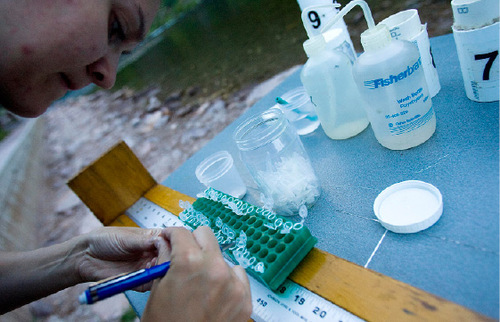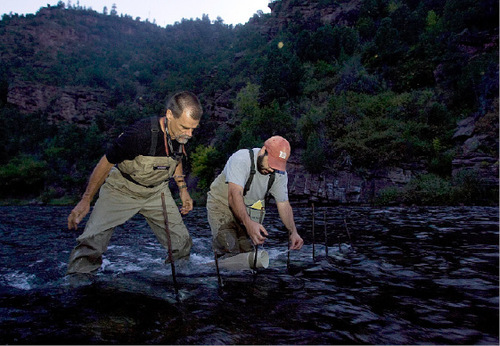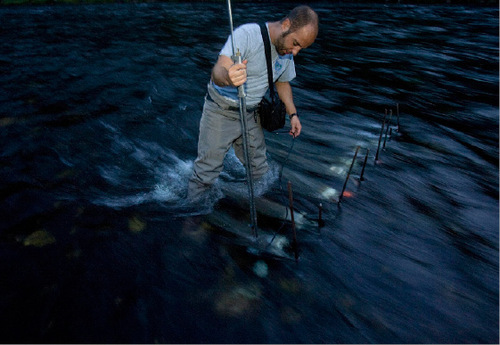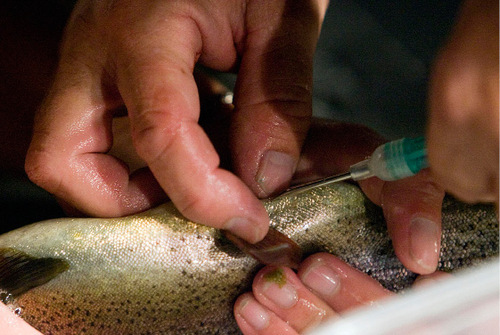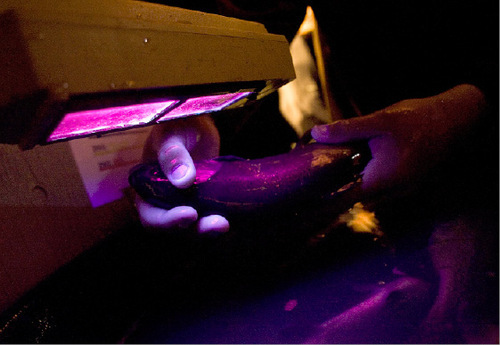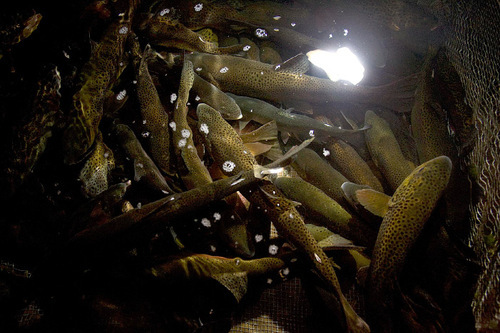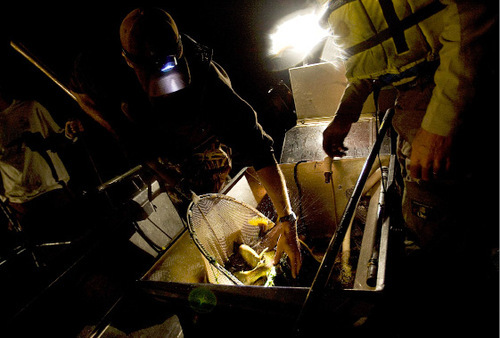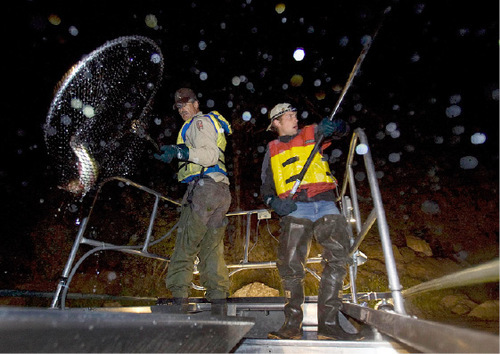This is an archived article that was published on sltrib.com in 2010, and information in the article may be outdated. It is provided only for personal research purposes and may not be reprinted.
The Green River, Daggett County • Red, green and yellow fluorescent body dyes glow under black lights and electric vibes that cause creatures to spastically dance.
This epic rave party takes place each spring and fall on the Green River below Flaming Gorge Dam. The unwilling partygoers are fish, primarily trout, and the DJs are wildlife biologists eliciting dance by sending electric shock waves through the water.
Welcome to the biannual electroshocking fish survey conducted by fisheries officials from the Utah Division of Wildlife Resources (DWR).
The survey — which helps biologists determine the population and general health of the fish — has been conducted for more than 20 years. DWR employees, joined by volunteers from other state and federal agencies and guides on the river, wait until dark and then launch a jet boat with two long rods sticking out in the front. Steel cables hang into the water as the boat captain maneuvers the vessel toward shore and flips the switch. And that is when the dancing starts.
"Things get pretty crazy when you hit the juice," said Ryan Mosley, Flaming Gorge/Green River Project Leader for the DWR. "Fish start freaking out trying to get away from the electricity."
Two people armed with long-handled nets lean against a railing on the front deck of the boat and lunge for every fish that has been temporarily paralyzed by the shock. The workers dash to scoop the fish before the Utah river current pulls them out of the shock field and try not to lose ones already in the net when attempting to get greedy with more before hoisting the booty to the side and into a tank on the boat.
The fish react in different ways to the power source. Some feel the twinge and bolt off as if they were blasted out of a water cannon, and some become flying fish during that short moment in their lives.
Others get hit with the wave of energy and stop moving altogether, making easy targets for the scoopers. Once the boat has made about a 1⁄3-mile run, the captain heads back to the ramp. The fish are moved to a holding bin in the river and then scooped in fours and fives to a big and hooded basin with a black light hanging over it like a reading lamp over a bed.
"We spray dye the rainbow trout with red, green or yellow in the hatchery just before we stock them. The different colors are different year classes," Mosley said. "The dye shows up under black light. It allows us to track year classes."
The state stocks roughly 25,000 rainbow trout in the river each year. Sometimes the dye markers are minuscule and hard to locate. Other times the fish looks like one of those glow sticks popular with kids on hot summer nights because it has been splattered with so much dye.
Brown trout, which reproduce in the river naturally, do not have the dye marker.
The fish are measured and weighed and then scanned — yes, scanned. A electronic scanner is run under the belly of each fish to see if it has been implanted with a PIT (passive integrated transponder) tag. The tiny transmitter allows biologists to track a specific fish as it grows.
"We have been tagging them since 2006 and there are about 9,000 in the river. We have a return rate of about 25 percent, maybe a little bit more," Mosley said. "There is a formula where you compare the number of fish you catch with the number of fish with tags and it gives you a rough estimate on the population."
Nine thousand fish may seem like a lot, but consider that some stretches of the Green carry as many as 14,000 fish per mile.
Once the fish have gone through the line of biologists, they are placed in large holding bins in the river to eliminate any chance they will be recaptured. At the end of the evening, typically around 1 a.m. or so, the cages are turned and the fish return to the river. Somewhere between 700 and 800 fish are caught each night of the project.
On this night the take was led by brown trout, followed closely by rainbow trout. Also hauled up were a half-dozen whitefish in the 4- to 5-pound class and a mottled sculpin. Random fish like kokanee salmon, smallmouth bass and lake trout from the reservoir have turned up during the electroshocking through the years.
Mosley was relieved, but not surprised, that burbot did not show up this fall. The highly predacious species was illegally introduced to the system and has been wreaking havoc on Flaming Gorge Reservoir. Biologists studying endangered species shocked up a burbot this spring in Dinosaur National Monument far downstream from the dam. Burbot are deep-water fish and are not likely to show up in shallow surveys. Mosley is concerned about the presence of the fish in the system.
Of the more than 700 fish, only the whitefish and one lone rainbow trout died before they were released.
For some fish, the poking, prodding and injecting don't end at the PIT tag table. During the fall dates, biologists from the Bug Lab, also known as the Bureau of Land Management/Utah State University National Aquatic Monitoring Center, select a few fish to have their stomachs pumped as part of an ongoing diet study.
"It is essentially a stomach content analysis to see what the fish have been eating," said Scott Miller, director of the Bug Lab, as he stuck a tube down a trout's mouth and pumped water to flush its stomach.
Biologists also take a small flesh sample from each fish to determine what they have been eating over the long term. The Bug Lab has been doing invertebrate studies on the Green below the dam for more than 15 years and have been doing the fish diet study for more than five years.
Miller said the fish in the first few miles below the dam show a low level of diversity in their diet and he range of food expands downstream. He said the trout rely heavily on midges, scuds and baetidaes. The number of terrestrial insects increases on the Little Hole sample, as does the number of fish with larger prey like other fish and mice.
Although the fish generally looked healthy on this evening, many had nothing or little in their stomachs.
"It is common to get fish with not much in their guts," Miller said. "It is about hitting them in their feeding patterns."
A Shocking Experience — The Video
See a video, including point-of-view and underwater footage, of the electroshocking project on Utah's Green River at http://www.sltrib.com/outdoors


